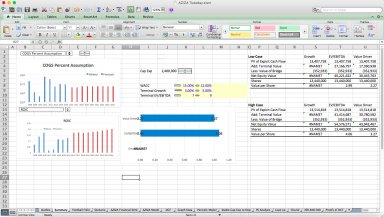
Originally published: 17/05/2018 14:57
Publication number: ELQ-85385-1
View all versions & Certificate
Publication number: ELQ-85385-1
View all versions & Certificate

Bridge from Enterprise Value to Equity Value Excel Model
Excel file to demonstrate the bridge from enterprise value to equity value.
Description
This Excel file shows you how to evaluate whether various elements should or should not be included in the bridge between equity value and enterprise value. It deals with things like the value of derivatives and deferred taxes associated with the derivatives. The proofs develop both true cash flow and the accounting for cash flow.
Just like a high project IRR can be a warning sign of pending over-capacity in project finance, a high ROIC can suggest that companies will try and enter the industry and increase supply. Indeed, evaluating ROIC is important in corporate analysis, but the statistic must be adjusted for goodwill write-offs, restructuring charges, impairments and other accounting items. Risk assessment in corporate finance involves judging how EBITDA can change due to factors such as technical obsolescence, changes in consumer tastes, changes in cost structure, and a host of factors including industry demand and supply that can create oversupply in an industry. Thorough analysis of any potential changes EBITDA are rarely dealt with in finance texts.
The use of multiples such as the P/E ratio and the EV/EBITDA ratio in valuation can result in biases without understanding how the multiples are affectedly assumptions with respect to long-term growth and long-term earnings potential. The EV/EBITDA ratio is strongly affected by the lifetime of assets used in the business and the necessity to replace capital expenditures.
This Excel file is a corporate model for a chicken producer, of which the returns are affected by changing politics. It shows how you can develop stable ratios and normalised cash flow. It includes stable ratio of capital expenditures and other issues as well as stable ROIC.
This file includes:
> Review of DCF
> Making a Cash Cycle Model
> Making a Waterfall Graph
> Scenario Analysis
> Making a Tornado Graph
> Football Field Diagram
> Normalising Adjustment for Cap Exp
> Normalising Adjustment for Working Capital
> Translation Adustments
> 1/2 Year Assumption
> LBO Model and Credit
This Excel file shows you how to evaluate whether various elements should or should not be included in the bridge between equity value and enterprise value. It deals with things like the value of derivatives and deferred taxes associated with the derivatives. The proofs develop both true cash flow and the accounting for cash flow.
Just like a high project IRR can be a warning sign of pending over-capacity in project finance, a high ROIC can suggest that companies will try and enter the industry and increase supply. Indeed, evaluating ROIC is important in corporate analysis, but the statistic must be adjusted for goodwill write-offs, restructuring charges, impairments and other accounting items. Risk assessment in corporate finance involves judging how EBITDA can change due to factors such as technical obsolescence, changes in consumer tastes, changes in cost structure, and a host of factors including industry demand and supply that can create oversupply in an industry. Thorough analysis of any potential changes EBITDA are rarely dealt with in finance texts.
The use of multiples such as the P/E ratio and the EV/EBITDA ratio in valuation can result in biases without understanding how the multiples are affectedly assumptions with respect to long-term growth and long-term earnings potential. The EV/EBITDA ratio is strongly affected by the lifetime of assets used in the business and the necessity to replace capital expenditures.
This Excel file is a corporate model for a chicken producer, of which the returns are affected by changing politics. It shows how you can develop stable ratios and normalised cash flow. It includes stable ratio of capital expenditures and other issues as well as stable ROIC.
This file includes:
> Review of DCF
> Making a Cash Cycle Model
> Making a Waterfall Graph
> Scenario Analysis
> Making a Tornado Graph
> Football Field Diagram
> Normalising Adjustment for Cap Exp
> Normalising Adjustment for Working Capital
> Translation Adustments
> 1/2 Year Assumption
> LBO Model and Credit
This Best Practice includes
1 Excel File














